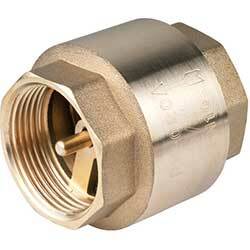Check Valves
-

Spring Non-Return Check One Way Valve Female x Female 12 Bar
Invena
£6.99Non return check valve fully made of brass with spring mechanism to let the water flow only one way. Check valve can last maximum pressure of 12 bar. There are range of sizes available. Specifications: - Material: Brass; - Insert material: Brass; - Size:...£6.99 -

Clack Non-Return In-Line Swing Check Valve One-way
Invena
£9.99The Clack Non-Return In-Line Valve Swing One-way Check Valves are the perfect solution to prevent water from returning to the source after being pumped away. This swing check type non return check valve is designed to ensure the flow of water remains...£9.99 -

Foot Check Valve Suction Non-Return Valve for Pumps Brass
Itap
£16.99The Foot Check Valve Suction Non-Return Valve for Pumps Brass is the perfect solution for ensuring optimal performance and preventing de-priming in dispensing pump systems. Designed for use in suction lines on top-offtake tanks, this foot valve is a...£16.99 -

Spring Check Non-Return One Way Valve Female Plastic Insert
Invena
£5.99The Spring Check Non-Return Valve Female With Plastic Insert is a highly reliable and functional product designed for water and central heating installations. With its efficient design, this valve ensures that fluid can only flow through it in one...£5.99
Check valves, also known as clack valves, non return valves or one way valves, are a fundamental component in a wide range of applications. They are designed to allow fluid, either liquid or gas, to flow through it in only one direction. With two openings in the body, one for fluid to enter and the other for fluid to leave, check valves are essential for regulating the flow of fluids in a controlled manner. Non return valves can be found in various household items, demonstrating their versatility and importance. Despite their wide range of sizes and costs, check valves are generally small, simple, and inexpensive. They are designed to work automatically and do not require external control, making them highly reliable for their intended purpose. You will not find any valve handle or stem on most check valves.
The bodies, or external shells, of one way valves are typically made of plastic or metal, ensuring durability and longevity. An essential aspect of check valves is the cracking pressure, which refers to the minimum upstream pressure required for the valve to operate effectively. By understanding the cracking pressure, specific check valves can be selected and specified for different applications, ensuring optimal performance.
Some of the products within this category include the foot check valve, suction non-return valve for pumps brass, clack non-return in-line valve, swing one-way check valves, spring non-return check valve one way female x female 12 bar brass, and spring check non-return valve female with plastic insert in sizes ranging from 1" to 3" inches. These check valves provide reliable control and efficient flow management for a variety of fluid systems.
Whether used in plumbing systems, HVAC systems, or industrial applications, check valves are essential for preventing backflow, maintaining pressure, and ensuring the smooth operation of fluid systems. These small and inconspicuous valves play a vital role in providing efficient and safe fluid management. With their automatic operation and wide range of options available, check valves are a reliable choice for controlling fluid flow in one direction.

 Read Reviews
Read Reviews